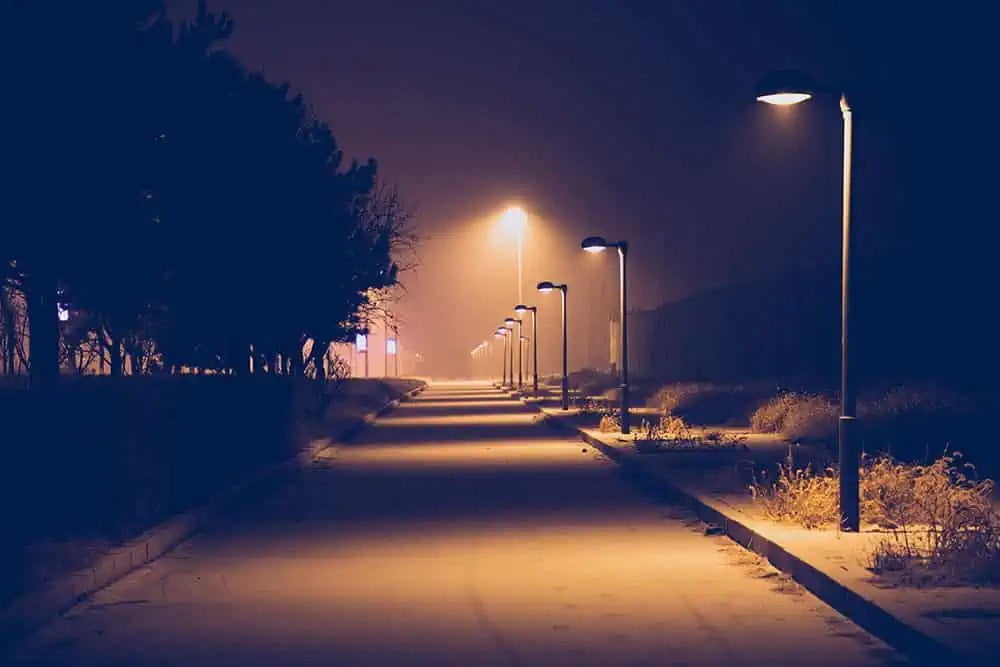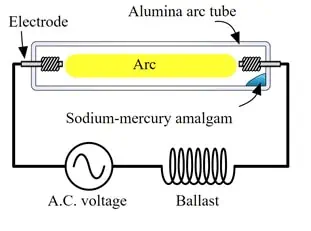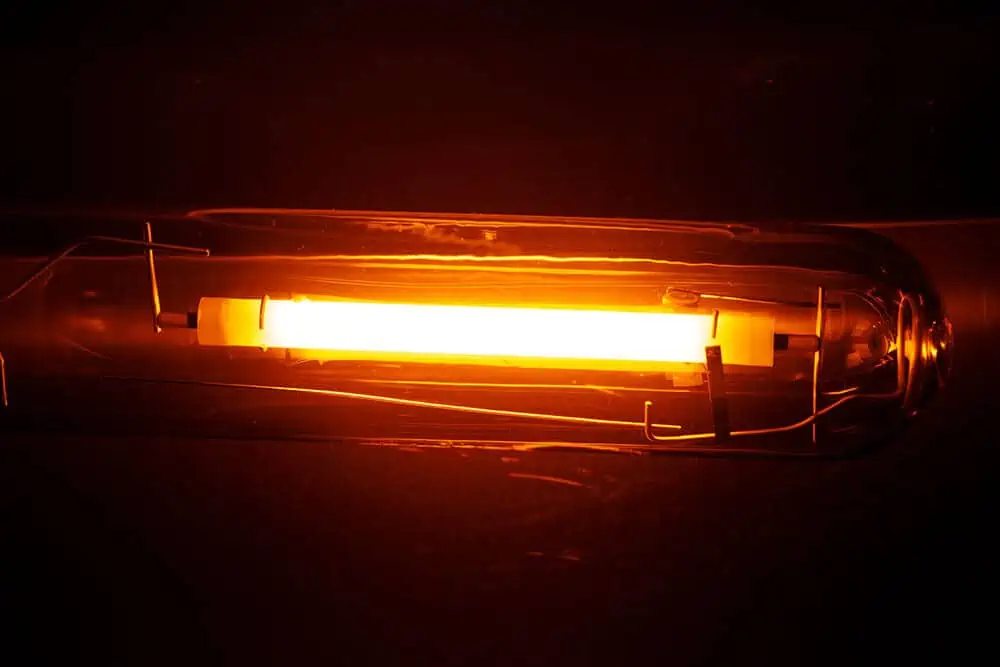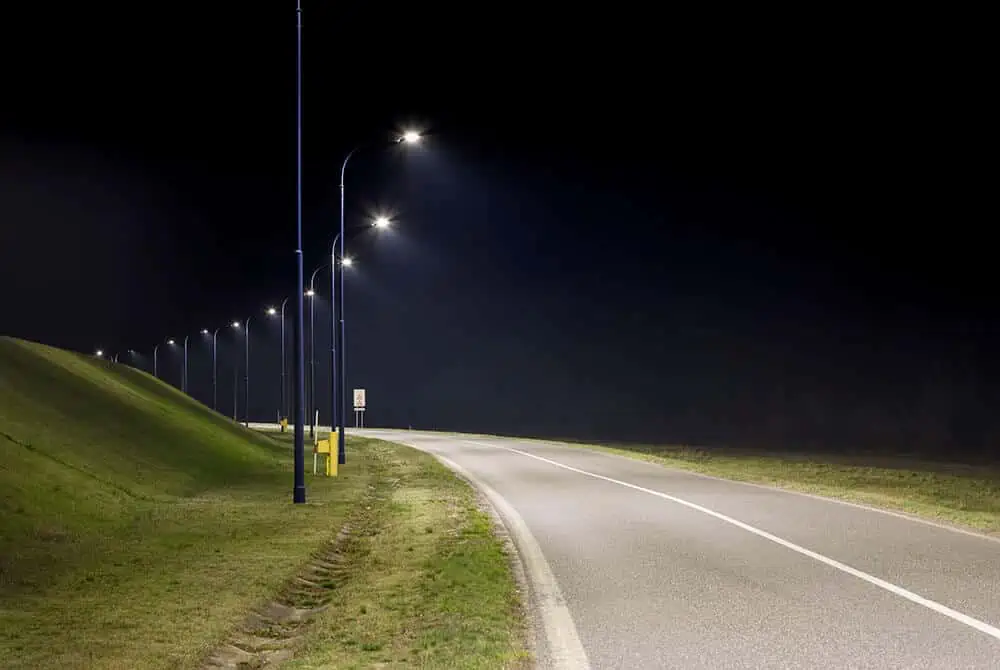LED vs High-Pressure and Low-Pressure Sodium Lights
Table of Contents
LEDs have significantly impacted the lighting industry. In the past, halogens and other technologies dominated, offering less efficiency. However, a significant shift has occurred with the introduction of LEDs, grabbing a substantial market share. Sodium vapor bulbs were once celebrated for their energy efficiency. But today, LEDs are increasingly becoming the go-to choice for most lighting needs. That being said, sodium vapor bulbs haven’t been entirely phased out.
The preference for LEDs over sodium vapor bulbs is not without reason. LEDs, a recent innovation, bring several benefits compared to sodium bulbs, with user-friendliness and exceptional efficiency at the forefront, making them a favorite worldwide.
This article delves into the specifics of sodium lamps and LEDs, discussing their advantages, disadvantages, and typical uses. We’ll highlight the situations where each type of bulb excels.

What is High-Pressure Sodium?
High-Pressure Sodium (HPS) is a highly efficient gas discharge light. They’re characterized by their high energy efficiency, emitting bright light over a vast area. Aluminum oxide is crucial in ensuring elemental sodium remains stable and managing high temperatures. When an HPS bulb is powered on, electricity triggers the ignitor, sparking an arc and illuminating the bulb. Initially, the bulb emits a sky-blue color due to ionized xenon. As it heats up, mercury vapors come into play, contributing a pale blue tint, which enhances the lamp’s color output.
The lamp’s hue evolves as different gases form with increasing temperatures. As temperatures climb, sodium ionizes, resulting in a characteristic yellow light. Mercury moderates the rate of sodium vaporization. At the arc’s peak temperature, the lamp radiates white light, harmonizing with sodium’s dominant yellow, creating a golden glow for the observer.
What is Low-Pressure Sodium Lamps?
LPS lamps, short for Low-Pressure Sodium Vapor, resemble their High-Pressure Sodium counterparts. Their design features a discharge tube housed within a glass body. Essential to their operation, metal electrodes are located within, transforming electrical energy into light. Yet, mere electrodes won’t suffice to illuminate the lamp. The bulbs contain argon and neon gases—elements you’d recognize from the periodic table. These gases, not abundant in nature, are synthesized in labs. Encased within the lamp’s glass, the gases interact with charged electrodes to create light. Metallic sodium complements this process, enhancing luminosity.
Comparing Low-Pressure and high-pressure Sodium Lamps
- Warm-Up Duration
- LPS and HPS lamps aren’t instant-on; they demand a warm-up period. This delay allows the gases inside to vaporize. Post-warming, they emit bright light corresponding to their wattage ratings. A cooldown is also necessary before re-ignition. Typically, an HPS bulb might take about 5 minutes to activate, while an LPS might demand up to 15 minutes.
- Impressive Lifespan
- Sodium vapor lamps, particularly low-pressure, can operate for up to 18,000 hours. Meanwhile, the more robust high-pressure version boasts a 24,000-hour lifespan. Before the LED era, sodium lamps were the top-tier choice for reliability. Their longevity and low upkeep make them a favorite for outdoor public area lighting, such as streets and parking spaces.
- Ignition Requirement
- Starting these lamps isn’t plug-and-play; a voltage pulse is needed to activate the arc tube inside. More minor variants demand lower voltage for ignition, while the larger ones need a heftier jolt.
- Evolving Energy Needs
- As these lamps age, their efficiency slightly diminishes. Over years of use, they could demand up to 10% extra voltage for the same light output, reducing their operational efficiency gradually
- LPS and HPS lamps score low on the Color Rendering Index (CRI). Specifically, LPS has a CRI of -44, which is relatively lackluster, especially when juxtaposed with HPS’s CRI of 25. This low CRI means discerning colors under LPS lighting can be challenging, often rendering vibrant hues as muted grays. HPS offers a broader light spectrum thanks to its mercury ionization. Among High-Intensity Discharge (HID) lamps, sodium variants rank lowest in CRI.
- Reliance on Ballast
- In line with other discharge lamps, both LPS and HPS necessitate a ballast—a device manufacturers integrate to modulate current consumption. The lights would overconsume power without this component, endangering the arc tube due to its inherent negative resistance. For HPS lamps, in particular, ballasts are indispensable, serving to kickstart the lamp by supplying the arc tube with an initial voltage boost.

Advantages & Disadvantages of High-Pressure & Low-Pressure Sodium Lamps
A broad spectrum of sodium lamps is tailored to various needs and specific types. High-pressure sodium lamps have wattages ranging from 35 to 1000 watts, whereas low-pressure sodium lamps vary between 35 and 180 watts.
It’s worth noting that sodium vapor lamps require some time to light up. However, low-pressure sodium lamps can restart more swiftly, reducing the initial warm-up period, particularly after a power interruption. Yet, they still need some time to achieve their typical light output. These lamps possess a low color rendering index, making it challenging to differentiate colors, especially beneath LPS lamps. Sodium is a volatile substance that can react explosively with air, so it’s crucial to safely safely dispose of used sodium vapor lamps.
Why Understanding High-pressure & Low-pressure Sodium Matters – Top Advantages
High Efficiency
Though HPS and LPS lights consume less power, they’re still less energy-efficient than LEDs. ‘ efficiency’ refers to the light output relative to power consumption. This is quantified in terms of lumens per watt. LPS bulbs shine brighter, with up to 180 lumens, compared to HPS bulbs, which offer around 150 lumens.
Expansive Illumination
When sodium bulbs are switched on, their light spectrum disperses broadly. This makes them ideal for illuminating expansive areas. Not only do they need less power to generate their luminosity, but the high-pressure sodium bulbs also emit a diverse range of colors. Their light is more evenly spread than other High-Intensity Discharge lamps.
Impressive Lifespan
The high efficiency of these bulbs contributes to their prolonged lifespan. They outlast many incandescent bulbs and other high-intensity discharge lamps. For instance, LPS bulbs can shine for over 14,000 hours, while HPS ones can last more than 24,000 hours.
Stable Luminosity Over Time
Both LPS and HPS lamps exhibit outstanding lumens retention throughout their lifespan. As they age, their light output height output has only a minimal decline.
Drawbacks of LPS (Low-Pressure Sodium) Bulbs:
- Monochromatic Light: LPS lamps produce a narrow spectrum, primarily in the yellow range. This makes objects illuminated by LPS lamps appear in shades of yellow and gray, which makes color differentiation impossible.
- Long Warm-up Time: LPS lamps can take 5-10 minutes or even longer to reach full brightness after being turned on.
- Low Color Rendering Index (CRI): The CRI of LPS lamps is extremely low, often around 0. This means that they’re poor at accurately rendering colors.
- Bulky Fixtures: LPS lamps require more extensive and heavier fixtures than other lighting technologies.
- Limited Applications: Due to their color rendering limitations, LPS lamps are best suited for applications where color differentiation isn’t essential, like highway lighting. They’re not suitable for residential or most commercial settings.
- Mercury Content: While minimal, LPS lamps contain mercury, which is hazardous if the bulb breaks and is an environmental concern for disposal.
Drawbacks of HPS (High-Pressure Sodium) Bulbs:
- Poor Color Rendering: Though better than LPS, HPS lamps still have a relatively low CRI, making colors appear washed out or distorted.
- Warm-up Time: Like LPS, HPS lamps have a warm-up period before reaching full brightness.
- Dimming Limitations: Traditional HPS lamps do not dim well. Special equipment or newer models are required if dimming functionality is needed.
- Reduced Efficiency Over Time: As HPS lamps age, they lose luminous efficacy, producing less light for the same amount of energy.
- Reduced Lifespan with Frequent On/Off Cycles: HPS lamps are best suited for applications that can remain on for extended periods. Frequently turning them on and off can reduce their lifespan.
- Mercury Content: Like LPS, HPS lamps also contain mercury, posing similar environmental and health concerns during disposal.
- Bulb Fragility: The internal components of HPS lamps, especially the arc tubes, are fragile. Rough handling or sudden jolts can break them.
- Heat Production: HPS lamps produce a significant amount of heat, which might not be suitable for all applications, especially indoor growing, where temperature control is essential.
While both LPS and HPS lamps have their places in specific applications, their drawbacks make them less versatile than newer lighting technologies like LED (light-emitting diode), which offer better energy efficiency, color rendering, and lifespan without many limitations associated with sodium vapor lamps.

Utilizing LPS & HPS Lighting: Various Uses
This segment delves into the multifaceted uses of LPS (Low-Pressure Sodium) and HPS (High-Pressure Sodium) lighting systems.
- Street Lighting
One of the predominant uses of sodium vapor lamps is in exterior lighting solutions. They’re extensively used to illuminate public spaces such as parking areas and roads. Given their proficiency in nighttime lighting, low-pressure sodium lamps effectively cover vast street expenses due to their dispersed light emission. LPS bulbs light many European streets. Their unique light quality is especially beneficial for tunnel illumination, ensuring driver comfort. Their efficiency remains undiminished even in adverse weather conditions like fog and rain.
- Industrial Illumination
The realm of industrial lighting often relies on high-pressure sodium lamps. Emitting a comprehensive range of light that spans 360°, they are optimal for areas like industrial zones and goods yards. Beyond their industrial applications, these lamps are versatile enough for residential exterior lighting. One standout feature of HPS lamps is that they maintain their peak output regardless of their mounting orientation.
- Indoor Lighting Solutions
Increasingly, HPS lamps find their place in interior settings such as garages and storage facilities. Specific HPS lighting variants are tailored explicitly for indoor applications. On the other hand, LPS lamps are less popular for interior use. Their exclusive yellow emission makes color differentiation challenging, casting a monochromatic, grayish hue on objects.
- Advertisement Illumination
Capturing attention is the essence of advertising. Ensuring an advertisement radiates appeal often involves surrounding it with ample lighting. This is where sodium bulbs come into play, enhancing the allure of advertisement boards.
Understanding Light-Emitting Diodes
LEDs are a remarkably efficient semiconductor compared to LPS or HPS bulbs. They are essentially p-n junction diodes crafted from specialized semiconductors. Their impressive energy efficiency and extended lifespan position them as top contenders in inductive lighting.
The fundamental principle behind LED illumination is electroluminescence. The diode releases light when subjected to an electric current, giving them the moniker “light-emitting diodes.” They are designed to allow electric current to flow only in one direction. As the current interacts with the p-n junction, electrons transition from one side to the other, filling the electron deficit.
This consistent electron movement results in the production of light. LEDs typically require low voltage for operation. As the applied voltage intensifies, so does the emitted light’s brightness, allowing LEDs to reach their peak illumination potential.
LEDs are versatile in color, ranging from yellow, green, and white to blue, pink, and beyond. The materials incorporated into the semiconductor component determine the specific color emitted to choose the particular color emitted.
Why Choose LEDs? Outstanding Benefits
- Extended Durability
Though LEDs come at a higher price than traditional bulbs, the investment is worthwhile. They boast an impressive lifespan, ranging up to 50,000 or even more, extending beyond 100,000 hours in some cases. Furthermore, LEDs endure four times longer than LPS or HPS bulbs. In the bigger picture, they offer superior longevity.
- Minimal Maintenance
Most LED lights have low to no maintenance requirements, offering significant savings, especially in upkeep expenses. The primary cost is a bulb replacement, which only arises after prolonged use. Hence, frequent bulb replacements, typical of other light varieties, aren’t an issue with LEDs.
- Remarkable Energy Efficiency
LEDs function efficiently even at cooler temperatures, emitting minimal heat—making them safe to touch. Their design ensures optimal light generation, converting electrical energy to light efficiently. Choosing quality LEDs from reputable manufacturers guarantees savings on electricity bills. LEDs enhance brightness with up to a 180° spread, potentially improving energy efficiency by 70%. Switching from conventional bulbs to LEDs can reduce energy costs by nearly 90%.
- Eco-Friendly
LEDs stand out for their eco-conscious design. Unlike traditional bulbs that release harmful emissions, LEDs emit minimal UV rays and have a reduced carbon footprint. They are free of hazardous elements like mercury, which is found in many fluorescent and sodium vapor lamps. Whereas conventional lamps with mercury need careful disposal due to risks like combustion, LEDs pose no such concerns, making them a safer choice for households and workplaces.
- Superior Light Quality
LED lights offer a bright yet gentle glow that closely resembles natural sunlight. With adjustable dimming features, users can regulate brightness, conserving energy and extending the bulb’s life. They come in diverse wattages and qualities, catering to specific illumination needs. LEDs ensure premium lighting even at low voltage.
- Efficient Cold Temperature Performance
While most fluorescent bulbs need higher voltage to function in cold conditions and might yield dimmer light, LEDs are an exception. They maintain consistent brightness regardless of the temperature. This makes them ideal for cold storage, outdoor installations, and public spaces like parking areas, streets, and airports, ensuring consistent luminosity even in colder climates.
Drawbacks of LED Lights
While LED lights offer numerous benefits, there are some slight drawbacks to consider, especially under specific conditions:
- Prolonged exposure to heat can sometimes lead to LED bulbs failing or having a diminished lifespan. This is more common in outdoor lighting scenarios, such as a street or public area lighting,, where bulbs face the sun for extended periods daily. Nonetheless, this is a manageable concern.
- Using lampshades can help shield LED bulbs from excessive heat. It’s worth noting that LEDs might come with a higher initial price tag compared to halogens and some other bulb varieties compared to halogens and some different bulb varieties.
- While LEDs are reasonably priced for most, a few might deem them slightly expensive. However, any initial costs are typically offset by their long-term savings, making the investment worthwhile.
Utilizing LEDs: A Versatile Approach
LEDs are revolutionizing how we utilize light, owing to their energy efficiency, reduced heat generation, and cost-effectiveness in production. With their varying sizes, they cater to diverse needs with ease.
- Commercial Spaces
LEDs dominate the scene in workplaces and commercial towers due to their brilliant luminosity. They trim down electricity expenses owing to their low energy use and excel in producing focused lighting without necessitating additional reflectors or diffusers. The direct 180° beam ensures optimized illumination where installed.
- Display Panels
From signage to traffic signals and large billboards, LEDs are the go-to. Their longevity and reduced power consumption make them ideal. Furthermore, they offer flexibility for multilingual displays and adaptable brightness settings.
- Vehicle Sector
The automobile world has embraced LEDs, pushing halogen lights to the sideline. In 2004, Audi’s introduction of LEDs as Daytime Running Lights marked a transformative phase. Their compactness, pristine light quality, and instantaneous activation have rendered them famous.
- Household Illumination
LEDs are a favored choice in home settings. Outclassing CFLs and traditional incandescent lights, they stand out with their color versatility, diminished heat production, and impressive lifespan. Their longevity surpasses CFLs by a factor of five and incandescent by thirty. They also offer many design and size options to match aesthetic tastes. For households with children, shatterproof LEDs LEDs are the way forward. Their plethora of designs, from chic to playful, can seamlessly blend with and enhance interior decor.
- Toy Production
LED-infused toys have witnessed a surge in popularity. Their gleaming allure draws children in, and their battery operation ensures safety from potential electrical hazards.
- Healthcare Uses
LEDs shine brightly in medical arenas. Surgical settings benefit from their clear, excellent illumination. Dentists admire their maneuverability and the clarity they bring. Phototherapy, which employs LEDs for accelerated wound healing, is another significant application.
- Digital Timepieces
LED-equipped watches have struck a chord with the youth. They are energy-efficient and provide unparalleled time accuracy. LED digits illuminate the time, a departure from traditional moving parts, and their long battery life cuts down maintenance intervals.
- Torches
LED flash is indispensable across sections and ensures military, security, and defense training. Their longevity,, combined with focused illumination, provides a practical, bright beam. This makes them ideal for challenging environments like dense forests or rugged terrains.

Contrasting Sodium Lamps with LEDs
- Unlike the omnidirectional nature of sodium lamps that emit light uniformly in every direction, LEDs are unidirectional, emitting light primarily in one direction.
- Sodium lamps have a shorter lifespan compared to LEDs. High-pressure sodium lamps can last 18,000 hours, while LPS extends up to 24,000 hours. In contrast, LEDs can shine brightly for over 100,000 hours, setting the benchmark for the longevity of light bulbs.
- LPS and HPS lamps need higher voltage to achieve their maximum output. However, LEDs generate the same brightness with a lesser voltage.
- Unlike sodium vapor lamps, Unlike sodium vapor lamps, LEDs illuminate instantly upon being turned on, eliminating the need for any warm-up period.
- LEDs boast a high color rendering index of 80, producing light resembling natural sunlight. In contrast, sodium vapor lamps have a distinct yellow hue. LEDs are more comfortable for the eyes than sodium vapor lamps’ glare sodium vapor lamps might exhibit inconsistencies such as flickering or reduced brightness. On the other hand, LEDs are known for their consistent and reliable performance throughout their lifespan.
Have Sodium Vapor Lamps Become Outdated?
They were once considered the pinnacle of energy efficiency, and sodium vapor lamps reigned supreme until LEDs appeared. Noted for their enduring lifespan, these lamps emitted a potent yellow glow illuminating vast areas. The low-pressure variants of these lamps radiate a distinct monochromatic yellow, which,, unfortunately,, renders colors like blue and green as shades of gray.
Such a color cast challenges color differentiation under this type of lighting. If you’re considering disposing of a sodium vapor bulb, tread cautiously. These bulbs can be hazardous due to the risk of combustion if the sodium within reacts with atmospheric oxygen. To mitigate this risk, shattering the bulb underwater is recommended preventing exposure to air. Once safely broken, the remnants can be discarded securely.
LEDs shine brightly, mimicking the qualities of natural daylight. In stark contrast to sodium lamps, LEDs’ light is gentler on the eyes. With an impressive color rendering index, LED lights faithfully reproduce colors, making it easy to tell them apart. Environmentally conscious, LEDs boast non-toxic components devoid of harmful substances like sodium or mercury. Their efficiency, coupled with virtually no upkeep costs, positions LEDs as a forward-thinking choice for illumination.
LEDs outshine in numerous aspects compared to both LPS and HPS lamps. This has led to the gradual decline in the popularity of sodium vapor lamps as LEDs surge forward. With cutting-edge advancements, LEDs are progressively replacing older sodium lamp applications.
Comparison of LED and Sodium Vapor Lights
Factors Of Comparison LEDs Low-Pressure/ High-Pressure Sodium Lamps Energy Efficiency LEDs are the most energy-efficient light bulbs. They consume less energy to produce high-intensity light. Sodium vapor lamps are not as energy efficient as LEDs. They consume high voltage to produce the same output. Cost It is pretty expensive when it comes to upfront fees. Both types of sodium lamps are less expensive compared to LEDs. Maintenance Cost Low maintenance cost as LEDs do not require any maintenance. Maintenance cost is comparatively higher than LEDs as lamps require replacement over time. Operate in Low Temperatures Works well with efficiency without reduction in the intensity of the light produced. Sodium lamps take more time to produce lighting with a decreased intensity. Lighting Directions Provide unidirectional lighting covering 180° and illuminating only in a single direction. They give omnidirectional lighting and cover 360° to illuminate the entire area. Consistent Lighting LED lamps stay consistent for years without having to replace the light. Sodium lamps are not very durable and tend to fail before their lifespan. Warm-up Time No warm-up time is required as they provide instant lighting when you switch on the light. Require a specific warm-up period to provide high luminance output. In HPS, the warm-up time is between 3 to 5 minutes, whereas, in LPS, the warm-up time is between 5 to 15 minutes. Life Span The average lifespan is between 50,000 to 100,000 hours. The lifespan of LPS is 12,000-18,000 hours. In HPS, the lifespan is up to 24,000 hours. Disposal Safe to dispose of anywhere without the need for special care. It nIt needs to be disposed of safely as these lamps may catch fire if broken. Heat Emission Emit less heat to produce a high luminance output. Emit high heat to produce the same output. Cycle Time It instantly turns on and off without flickering. Lamps start to flicker when they are turned on and off continuously. Size Available in different sizes from very small to larger sizes. Available in different sizes but not as small as LEDs. Conclusion
The comparative analysis indicates a clear superiority of LED lights in several domains. Whether considering efficiency, durability, or other metrics, sodium vapor lamps cannot match the performance of LEDs. Hence, the current trend leans heavily towards LEDs, especially as they become more accessible and cost-effective for a broader audience.
For top-notch LED strips and LED neon flex suitable for indoor and outdoor applications, reach out to MyLikeLed. Your ideal solution for linear lighting awaits!
- As these lamps age, their efficiency slightly diminishes. Over years of use, they could demand up to 10% extra voltage for the same light output, reducing their operational efficiency gradually
FAQs
The main difference between LED lights and sodium lights (both high-pressure and low-pressure) lies in their technology, efficiency, and light quality. LED lights use semiconductors to produce bright, white, and directional light, while sodium lights use gas discharge to create a yellow or orange glow. LEDs offer better color rendering, energy efficiency, and longer lifespan than sodium lights.
Yes, LED lights are significantly more energy-efficient than high-pressure sodium (HPS) lights. LEDs convert more electricity into usable light with less heat loss, which helps reduce energy consumption and utility costs. HPS lights consume more power and often require additional components like ballasts.
Yes, LED lights typically last longer than low-pressure sodium (LPS) lights. The average lifespan of an LED fixture ranges from 50,000 to 100,000 hours, while LPS lights usually last around 18,000 to 24,000 hours. This means less maintenance and fewer replacements with LEDs.
LED lights provide much better color rendering than both high-pressure and low-pressure sodium lights. LEDs have a high CRI (Color Rendering Index), making objects appear more natural and vibrant. In contrast, sodium lights, especially LPS, have a very low CRI and often distort colors with their strong yellow-orange hue.
Sodium lights may have a lower initial cost than LED lights, but LEDs are more cost-effective in the long run. LEDs save more on electricity bills, require less maintenance, and last longer—resulting in lower total cost of ownership over time.
LED lights are generally better for outdoor lighting compared to high-pressure sodium lights. LEDs provide clear, uniform illumination, are available in various color temperatures, and reduce light pollution. HPS lights offer less visibility and poor color rendering, which may not be ideal for safety and aesthetics.

Hi, I’m Xylia Xiong, a sales professional with 14 years of experience in the LED strip light industry. I specialize in providing tailored solutions, leveraging my expertise in LED products and the latest industry trends. Known for effective communication and problem-solving, I’m dedicated to helping lighting manufacturers, importers, and distributors achieve their goals.
Let’s work together to create customized solutions that exceed expectations.
Related Posts

The Best LED Strip Lights You Can Buy Right Now

Comparing WS2811 Vs WS2812B: Key Differences





